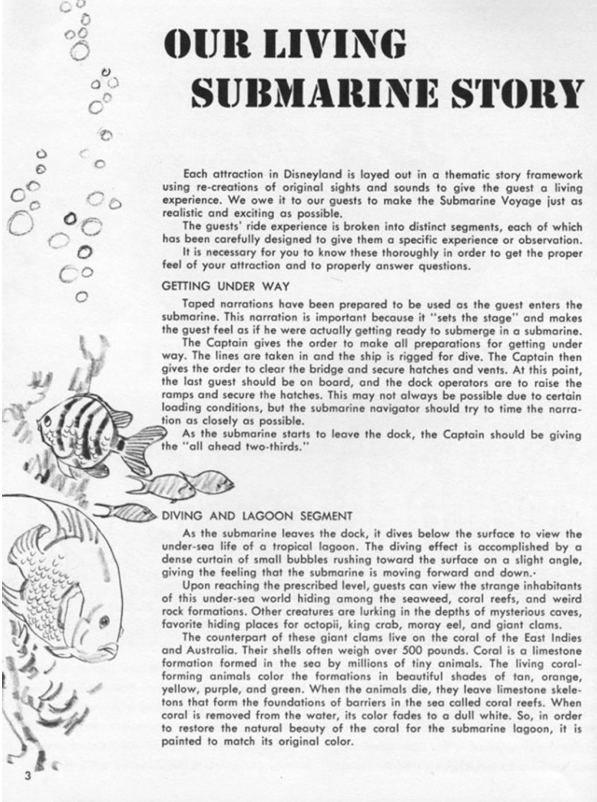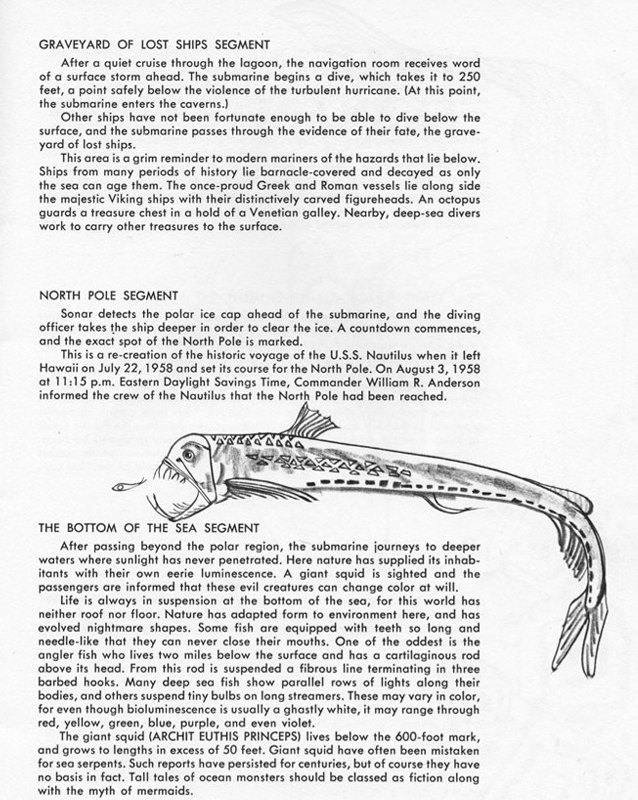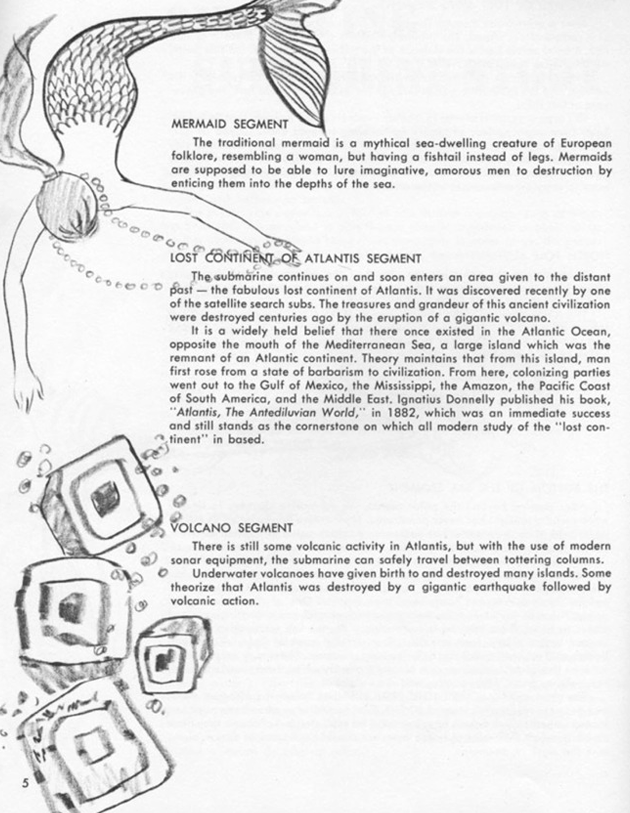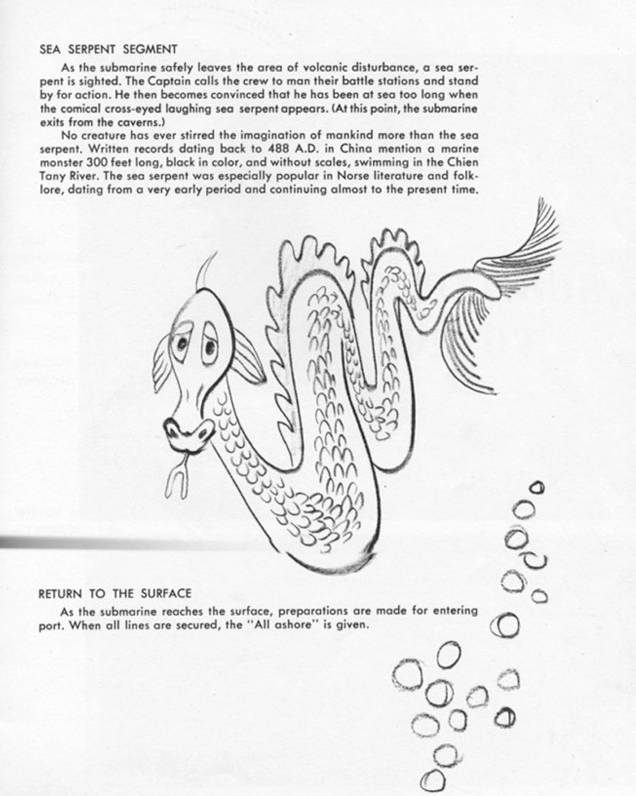Amusement Odyssey
Everything Short of a Submarine: Walt's Peacetime Submarine Fleet
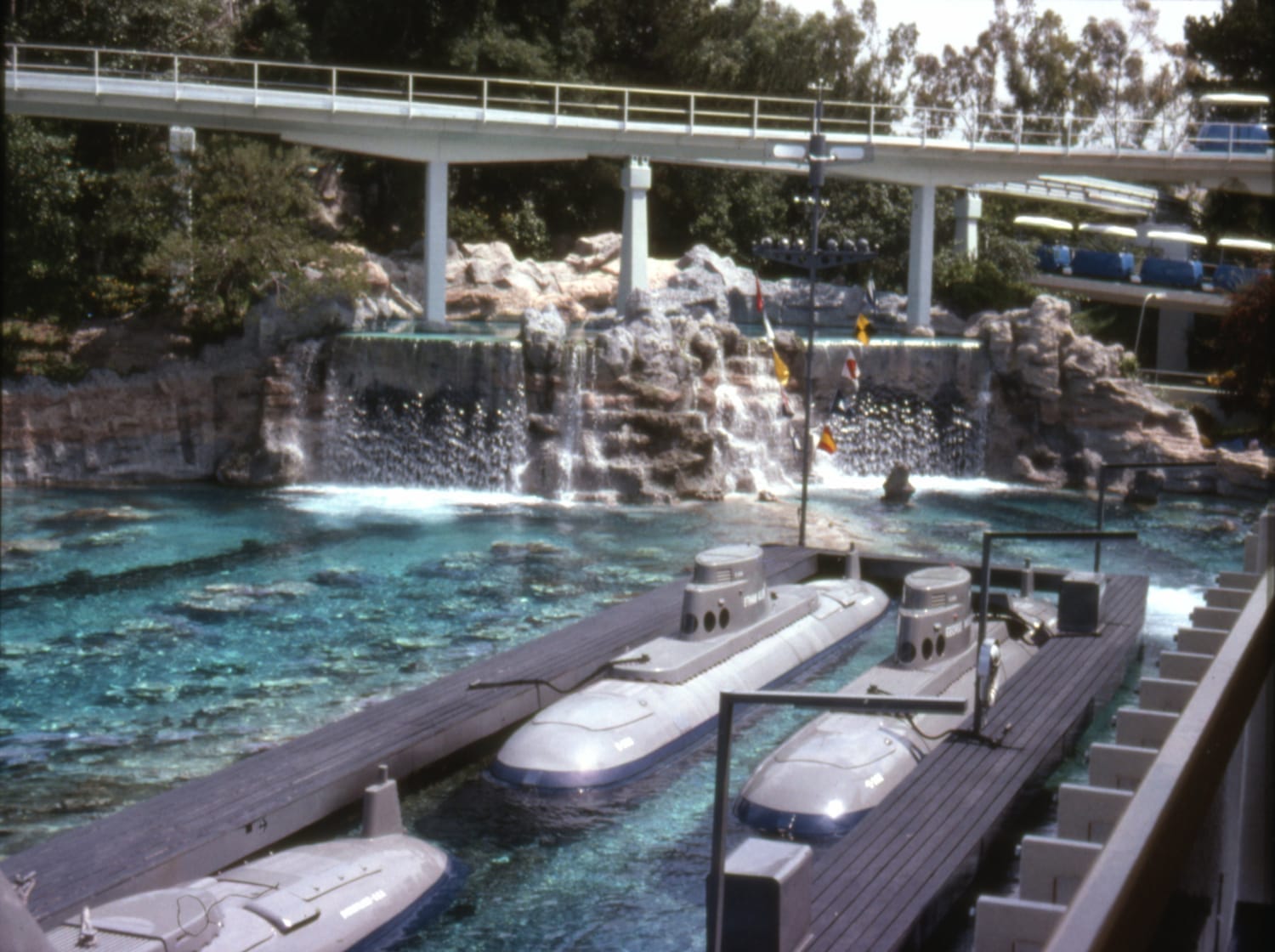
Credit: foundin_a_attic
With the closure of the Phantom Boats in 1956, Tomorrowland had a small hole in its ride lineup that Walt Disney intended to fill by 1959, the park’s first major expansion. One of the initial ideas was that of a glass-bottomed boat that guests would look through while traveling around Tomorrowland Lagoon. The attraction would include underwater life (even live sea animals) and a small show to entertain riders. Since Jungle Cruise was one of the most popular attractions at the park, another boat ride seemed like a winner. Little did anyone know, a side comment by Truman Woodworth sparked the development of a different ride vehicle for the attraction. “Walt’s got everything here except for a submarine.” Roger Broggie mentioned this to Walt, and immediately he wanted a submarine ride vehicle that took guests underwater to view the scenes.
A real-life submarine diving several feet below water was certainly one of the grandest concepts for an attraction at the time; however, the execution of it became too complex to complete. Bob Gurr and Roger Broggie were responsible for the vehicle design. They had visited San Francisco to observe the cable system used by cable cars as a potential drive mechanism. One big issue at hand was that in the event the cable were to break, it would be very difficult, almost near impossible, to safely evacuate riders from the submarine. Therefore, the submarines were designed to never go completely underwater. Instead, the riders would board the subs from ground level and travel down a staircase to their seats, which were below the water level. From the moment the submarines leave the station area, they do not change grade at all during the ride.
Instead, each submarine was independently propelled by its own diesel engine and propeller, and followed an underwater guide track, much like the technology used at Jungle Cruise. To guests on the surface however, they would quickly realize that the submarines did not fully descend underwater, ruining the illusion, so a ride system that hid this flaw was necessary.
After traversing through the first portion of the ride in Tomorrowland Lagoon, the submarines entered a large show building, which is the point in the ride where the submarines mimic descending below the surface. One of the largest show buildings ever produced for an attraction, it was necessary to mask the building with landscaping to hide the large concrete bunker from guest view. Bill Evans, who had worked on Disneyland’s landscaping, including the complex landscape for Jungle Cruise, hid the building with plants and trees to create the illusion of a forest behind a waterfall. Many guests who are riding on Autopia and the Disneyland Monorail are completely unaware that they are travelling over the roof of the building where the Submarine Voyage takes place, as even the roof was to include landscaping to appear as if the ride is going over a park.
Inside of the building, Claude Coats and Bob Sewell worked on the show scenes, Roger Broggie and Wathel Rogers created the animation, and Bill Martin worked on the track layout. Ub Iwerks was to create any projections necessary for the show. Marc Davis, Dick Irvine, Emile Kuri, as well as a full team of craftsmen, electricians, and plumbers, also contributed towards the attraction’s creation. At one point, it was considered to include real fish and sea life for the ride, but was deemed to be too complex.
With an idea in place, Bob Gurr was still working on the actual vehicle design and functionality. He contacted General Dynamics, a military and defense corporation, for technical assistance with the submarine design. Walt Disney desired a sleek, aluminum shape for the subs, pulling out a cigar holder to Imagineer Harper Goff to demonstrate his vision. However, Goff was able to persuade Walt into a different design, one that had more undertones of steampunk appearance, taking inspiration from the shape of alligators and sharks.
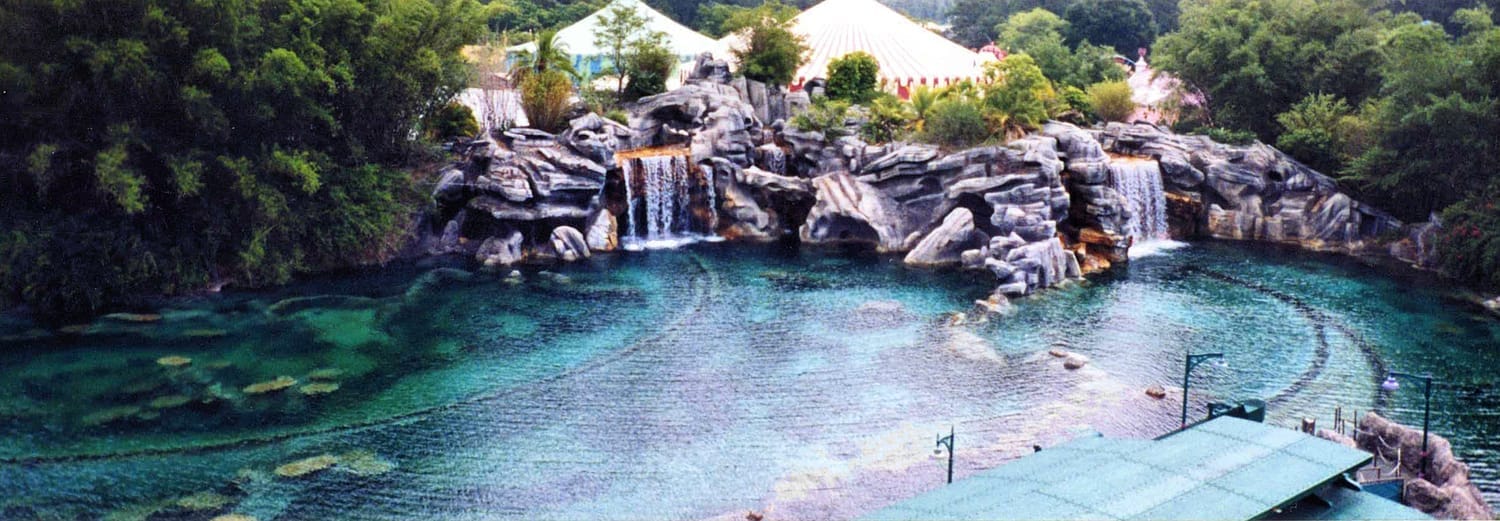
Credit:Larry D. Moore
A fleet of eight 52-foot-long submarines was created, each holding 38 riders. Diesel generators powered an electric 240V motor for the 4-blade bronze propellers, which were almost three feet in diameter. Submarine 304 (Explorer) ran on natural gas as opposed to diesel fuel as a study for conservation and performance. Each ship was fabricated at Todd Shipyard in San Pedro, at a cost of $80,000 each. Retired Navy Admiral Joe Fowler helped supervise the design and fabrication; however, he had to be careful with what information could be given to Disney, as certain aspects were still considered government secrets. This also prevented the US Navy from joining the project, as they had considered assisting as well. Each submarine was painted battleship grey with a black hull. The portholes that guests would look out of were hand-carved, then a mold or model was used to replicate the rest.
With the vehicle design created, a story was needed for the attraction. The basis for the story took similarity to that of 20,000 Leagues Under the Sea, a popular Disney film from 1954. However, Tomorrowland already offered a walk-through attraction featuring props and scenes from the film. The more generic Submarine Voyage name was chosen for the attraction, as guests may have thought the attraction was the same one already offered at the park. On August 3, 1958, the USS Nautilus (named after the submarine from the film) became the world’s first nuclear-powered submarine and also the first to descend below the North Pole. This event would inspire part of the ride’s plot.
Claude Coats and Bob Sewell created a plotline that created several scenes of an underwater journey. Upon leaving the loading area, the subs cruised around Tomorrowland Lagoon observing sea life. After word of a surface storm ahead, it is time for the submarines to descend 250 feet below sea level. At this time, the ships are going beneath the waterfall into the show building. An illusion of bubbles alongside the portholes into darkness completes this effect for guests.
The submarines enter the “Graveyard of Lost Ships,” depicting sunken shipwrecks of boats from various eras and divers examining the ships to recover treasures. At this time the submarines are approaching the ice cap of the North Pole, which the submarines are to dive underneath, reminiscent of the 1958 Nautilus mission. Guests now begin to see mermaids underwater, which the ship’s captain believes are a hallucination, and he asks for the cabin pressure to be checked. The ship continues to an area believed to be the ruins of the Lost Continent of Atlantis, where it must traverse through columns to avoid collision. Now reaching the ride’s climax, a gigantic sea serpent appears from a series of underwater volcanic activities. Informing the crew to get to their battle stations, the face of the comical serpent appears, leading the captain to conclude it is time to return to shore. At this time, the submarines travel back to the loading dock for guests to disembark from their journey.
Test rides of the attraction held several members of the US Navy, almost all of whom were fooled by the illusion and believed that the ships were actually underwater during the ride. In addition to the show scenes, sea life including coral reefs, seaweed, giant clams, battling lobsters and crabs, sea turtles, sharks, eels, and a variety of fish were included for guests to observe. The work put into the Submarine voyage was certainly some of the most ambitious to date for a single attraction.
On June 14, 1959, the attraction was opened, and christened by Mildred Nelson, a former Women Accepted for Voluntary Emergency Service (WAVES) and her husband, Stuart Nelson who was chief machinist for the original USS Nautilus. Vice President Richard Nixon was one of the passengers on the maiden voyage. Famously, Soviet Premier Nikita Khrushchev wanted to visit Disneyland in 1959, but was denied due to security reasons. Walt Disney was disappointed, as he jokingly wanted to introduce the Premier to his submarine fleet, which was the world’s eighth largest at the time. Through the years, the ride required an “E” ticket.
Blending into the theme of Tomorrowland, the fleet was said to be “nuclear powered,” a modern concept for the time, and one that Walt always wanted to incorporate into the land. Each ship was captained by a single driver, who had to follow a strict 17-page operating manual. The operators stood in a “conning tower,” which allowed them to see ahead of the ship to control its speed throughout the voyage. A seat was present at one point, but this led to operators not paying as close attention, and a few collisions occurred. This led to the removal of the seat, forcing them to stand through the whole ride. Guests entered the submarines from the dock through a spiral staircase and pulled down on their spring-loaded seats for the ride, although the submarines have always been noted to be quite cramped.
The eight submarines were originally named after real US submarines:
Nautilus (D-301)
Seawolf (D-302)
Skate (D-303)
Skipjack (D-304)
Triton (D-305)
George Washington (D-306)
Patrick Henry (D-307)
Ethan Allen (D-308)
Here is a description from the operating manual of each show scene:
One of the most popular segments of the journey has always been the mermaids. This is one of the few Disneyland attractions using real humans as performers as opposed to Audio Animatronics. For promotion of the attraction in 1959, auditions were held at the Disneyland Hotel pool. Mermaids were required to learn how to swim with a Naugahyde tail in synchronization with other performers and be accustomed to being in the Lagoon all day long. While only around for the opening year, the decision was made to bring the popular performers back for the park’s ten year anniversary in 1965 as a permanent feature. However, this was problematic from an operational sense. After a while, mermaids began to suffer health issues from the attraction. Not only did the chlorinated water affect their hair color, but the exhaust fumes from the diesel engines were also an issue. In addition, male guests were fascinated by the performers and at times, attempted to swim out to them to meet them. As a result, the live performers were cut in 1967, and replaced with animatronic figures instead.
Submarine Voyage quickly amassed some of the longest lines in the park. Guests were mesmerized by the effect of being underwater, as well as the beautiful show produced for the ride. Some of the long queue times could be credited to the slow-loading nature of the submarines. Although popular, the attraction required very timely and extensive maintenance to keep it up to standards.
Each day, a team of divers went underwater to clean up the ride, as well as repair any defects necessary. Rehab for the attraction consisted of “all hands on deck” and was one of the largest maintenance projects for any Disneyland attraction. In order to properly service the ride, the Tomorrowland Lagoon needed to be fully drained, over 9 million gallons of water. This process was done in thirds to avoid disrupting the “ocean floor.” Once drained, each of the 126 moving figures, 180 static figures, and 10,000 plants were evaluated for repairs and removed if necessary, requiring removal of silicone used to glue and seal the figures. The Lagoon was completely scrubbed clean before repainting, which utilized special chlorine-resistant paint costing $150 a gallon at the time. At this time, any repairs to the actual Lagoon and trough were considered as well. In 1964, the ride track required a complete replacement. For the large 1986 rehab project, a massive leak (over 40,000 gallons a day) was repaired between the Lagoon and the Motor Boat Cruise ride.
Once all repairs were complete and all figures were back in place, the Lagoon could be refilled. Since the fresh water would clean off any leftover construction material, the filtering system, which had a capacity of 3,000 gallons per hour, took around a week to clean the water again. Chlorine is added to the water to keep it clean and prevent algae growth. Once clean, a certain level of “murkiness” is given to the water to provide the exact view that Imagineers require for the show element of the attraction. A special “cathodic protection” is applied to the water through low-voltage probes, which delays the process of oxidation and rusting to the ride’s metals and coatings.
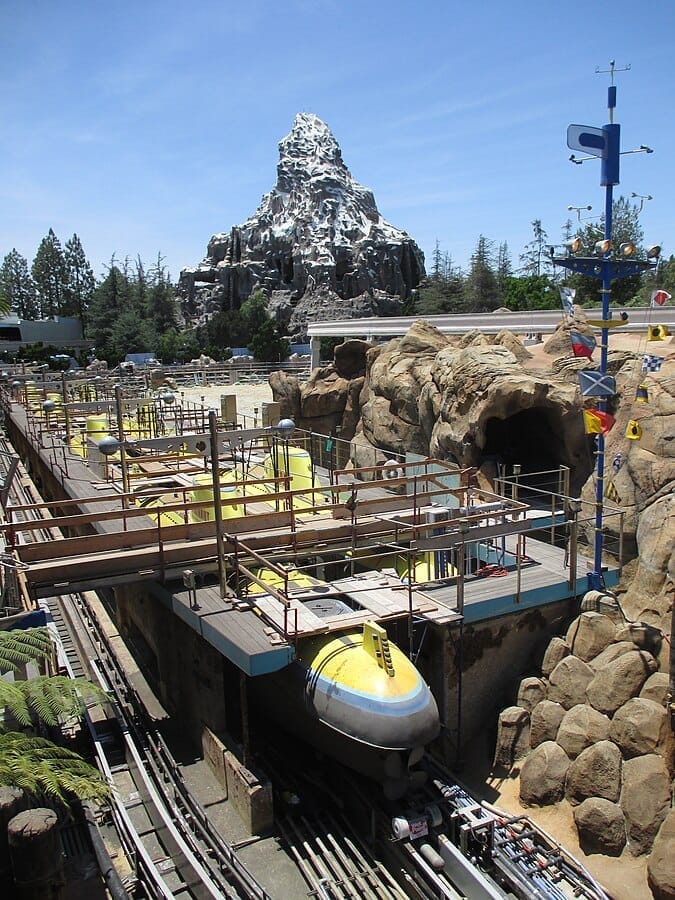
Credit: Patrick Pelletier
Submarine Voyage remained virtually the same throughout the years, until the aforementioned 1986 rehab, which was the largest to date. Several new figures and scenery were added to the lagoon, in addition to the traditional cleaning and repainting of scenes. Each submarine was repainted to a bright yellow color with white towers and blue/pink trim. However, the paint could not hold up to the highly chlorinated environment and began to peel off. Therefore, they were repainted again to a different yellow, with orange and black trim. Yellow submarines are noted to be for “research purposes” which is why the park decided to go with this color scheme. These submarines remained unchanged until the original ride’s closure in 1998.
These are the updated submarine names that came with the 1986 refurbishment:
Nautilus (301)
Neptune (302)
Sea Star (303)
Explorer (304)
Seeker (305)
Argonaut (306)
Triton (307)
Sea Wolf (308)
Rumors began to circulate about the ride’s demise in 1998. Magic Kingdom at Walt Disney World closed its 20,000 Leagues Under the Sea four years prior in 1994 permanently. The costly attraction was in need of another major refurbishment, and Disneyland President Paul Pressler essentially confirmed the rumors, only giving a date of 2003 for the proposed replacement, noting that they understood the importance of the attraction. On September 8, 1998, the Submarine Voyage closed in its original form, sitting untouched for several years. Finally, in 2001, some work was seen going on in the lagoon, possibly for a new layover.
Disney released a movie that same year titled “Atlantis: The Lost Empire”, which would have been a perfect theme for the underwater attraction. Unfortunately, the film was regarded as a box office flop, and as a result the proposal was likely scrapped, as the film did not resonate with viewers as closely as desired. The following year, another proposal was given, themed around 2002’s Treasure Planet, another box office failure. At one point, a Little Mermaid overlay was considered, but did not get very far into development. Disney executives considered scrapping the large submarines, as they took up a lot of the park’s storage space. Marty Sklar hired a naval inspection firm to evaluate the submarines, and they concluded that the vessels still had between 40-50 years of useful life remaining. This in turn saved the submarines from being demolished and removed.
It wasn’t until 2004 that work was seen going on in the drained attraction yet again, a full year after the submarines were scheduled to reopen. This time, a new underwater film had debuted from Disney Pixar in 2003. Finding Nemo was a huge success, beloved by many people in theaters. It was decided that this was the new direction to go with the attraction, still retaining the underwater theme, but also utilizing a popular brand.
Work was underway to refurbish the attraction completely, and introduce a new storyline. Tony Baxter, then Senior Vice President of Creative Development at Disney Imagineering, was appointed to head the new attraction’s creation. He previously told Paul Pressler after hearing word of the submarine’s closure that he was deeply saddened by the announcement, as it had been one of his favorite attractions, and that something needed to be done.
Part of the attraction working against it was the costly rehab projects required to keep it operating. Therefore, a new system was required to cut down on the maintenance. Inside the show building, each scene was constantly underwater, meaning that either divers needed to maintain them, or the lagoon needed to be drained to access them more easily. So, a new illusion was created to keep the subs underwater but the show elements dry. The ride path of the submarines was enclosed by panes of glass, which sealed the track but kept the animatronics and scenes out of the water. In order to keep the underwater illusion, the panes of glass must not intrude on the sightlines of the guests. Now, anything requiring maintenance could be accessed easily and did not require major renovation.
Models were created to display the new story and effects, and despite the major cost, the Finding Nemo ride was approved by Matt Ouimet, the new President of Disneyland Resort. In addition to the 126 sea creatures and over 10,000 aquatic plants, new projection technology would be displayed onto screens, depicting Nemo and his friends. The projections were to accompany the show scenes and added a whole new dimension to the attraction. With the lack of moving parts, the projections were also reliable and did not intrude with the water present in the ride track.
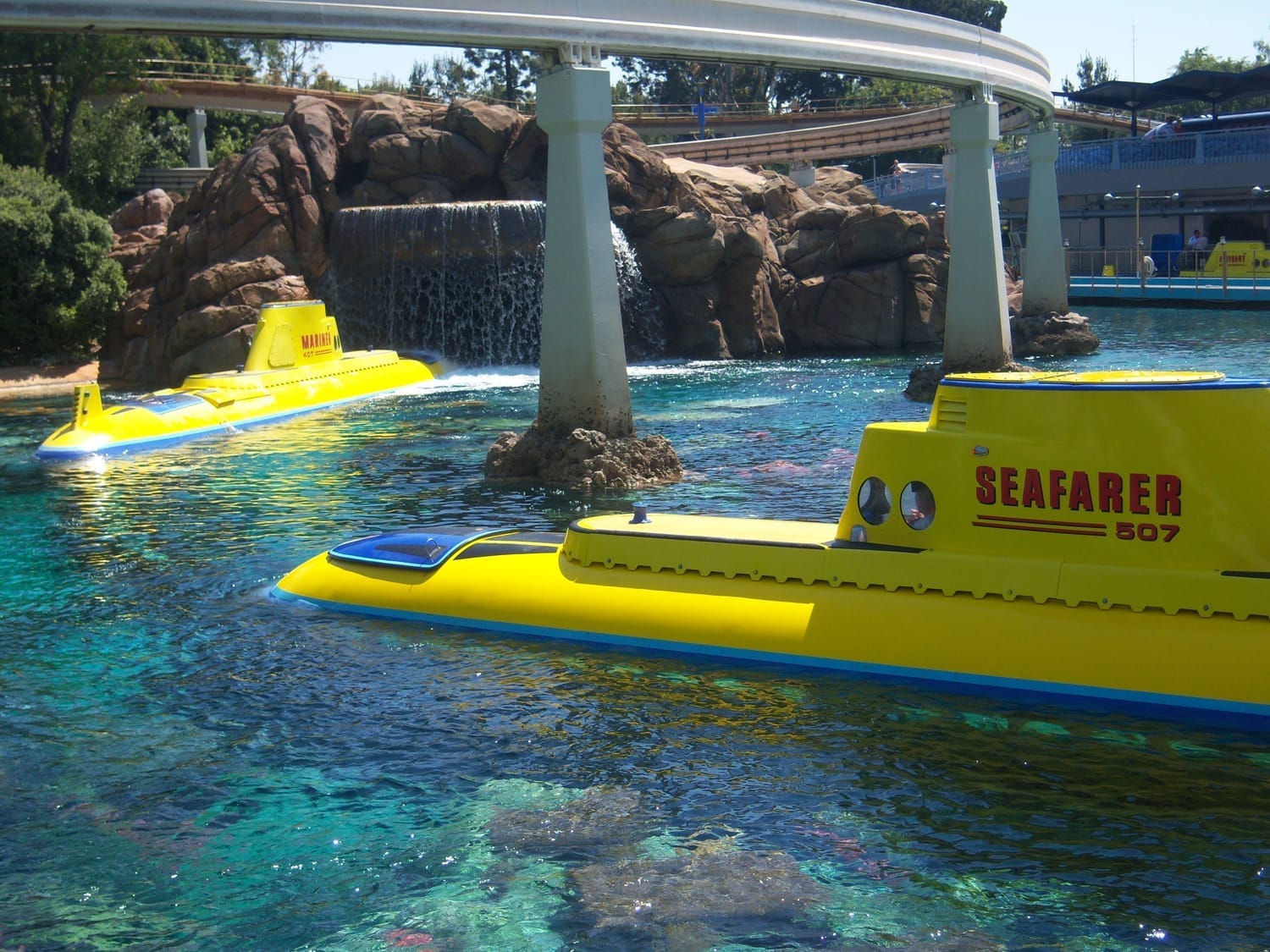
Credit:Loren Javier
Guests enter the Nautical Exploration and Marine Observation (NEMO) facility, and board a research submarine that is in search of active underwater volcanoes. The submarines begin on the outdoor portion of the ride exploring a coral reef and ancient ruins, with movie characters Darla and P. Sherman also visible exploring for treasures. With a surface storm ahead, the submarine dives underwater into an underwater cavern. Using sonar technology, the submarine is able to communicate with fish. Now passing characters Marlin and Dory, they reveal that Marlin’s son, Nemo, has gotten lost again, which had happened in the movie. Nemo’s teacher, Mr. Ray (a manta ray) is also looking for Nemo.
Entering the East Australian Current, guests see Nemo along with Squirt and other sea turtles swimming along the current. The submarine encounters a graveyard of ships, while Marlin and Dory continue their search. Sharks Bruce and Chum, antagonists from the film, are seen swimming near a sunken submarine and minefield, which the riders' submarine accidentally contacts, causing the submarine to temporarily lose power. Marlin and Dory encounter small glowing lights, which turn out to be an anglerfish on the seafloor, and are forced to escape through a forest of jellyfish.
Finally reaching the active volcano, Marlin and Dory are reunited with Nemo, and must escape as the volcano begins to erupt. At this point, the sub and Dory are swallowed by a humpback whale, which Dory tries to communicate with the whale. The submarine and Dory are shot out of its blowhole, and Dory mistakes the yellow submarine for a whale, saying goodbye to it.
The captain tells his crew not to record anything from the journey, as nobody would believe them, and it is time to return to shore before they encounter a sea serpent or mermaid (paying homage to the original attraction). Exiting the show building, the submarine ascends back to the surface and returns to the dock.
In order to create the new ride environment, the entire coral reef and Lagoon required refurbishment. An advancement in the paint coating was made through the use of over 30 tons of crushed glass. The recycled material was mixed in batches to create a series of around 40 different colors, and applied to the coral reef segments. This coating would be more durable and long lasting than the original paint.
Each submarine was converted from the fume diesel engine setup to an all-electric drive. Disney worked with the company ENRX of Norway to create a first-of-its-type power transfer system. A battery system aboard each submarine powers its drive components; however, these batteries need to be charged. Power transfer in an underwater environment eliminated a lot of traditional technologies used on other attractions as unfeasible. ENRX developed a technology utilizing Inductive Power Transfer (IPT) that uses contactless magnets to transfer energy to the submarines as they pass over charging bases. Essentially, it is a much more powerful version of a wireless phone charger. With a contactless system, power could be reliably transmitted without physical mechanical components touching underwater.
The updated fleet of submarines was repainted with a fresh coat of yellow and blue trim. Each hull is a blue-black color, which was chosen to limit reflection. One of the most complex portions of animating the new scenes was synchronizing each scene to each porthole in the sub. Since the subs were so long, guests in the front of the boat would see a scene before guests in the rear. So, speakers above the seats would play the soundtrack at specific times, leading to a full synchronization of the scene to the rider. Laser beams within the show building tracked the position of the subs to start scenes at the appropriate times. To increase capacity, each submarine was increased from 38 to 40 seats.
The subs are named:
Argonaut
Explorer
Mariner
Nautilus
Neptune
Scout
Seafarer
Voyager
The new Finding Nemo Submarine Voyage opened on June 11, 2007, to great reviews. Guests were extremely satisfied to see a beloved attraction return, with a new story and many new features. Since reopening, the ride has undergone two major refurbishments, one in 2014 and one in 2021, to revitalize the coral reefs and show scenes. In the latter refresh, a figure of Hank, an octopus seen in Finding Dory, was installed in the Lagoon.
